Porto-North-Portugal.com
The best independent guide to north Portugal
Porto-North-Portugal.com
The best independent guide to north Portugal
Braga - The best sights and attractions in 2026
Braga's rich heritage spans centuries of Portuguese history, offering visitors a fascinating blend of Baroque splendour, religious significance and Portuguese authenticity. This ancient city seamlessly combines its spiritual past with vibrant modern life.
From its collection of ornate baroque churches and peaceful gardens to its lively café-lined squares and historic monuments, Braga invites visitors to explore over 2,000 years of its history. The standout attraction is the magnificent Bom Jesus do Monte sanctuary, standing high above the city and reached via an elegant baroque stairway.
This guide will detail the best sights and attractions of Braga, helping you make the most of your time in this fantastic city.
The best of Braga
The following list details the best of Braga, which should not be missed during your visit to the city. Following this section is an interactive map to help you plan your trip and this is followed by a detailed description of each of the sights.
Bom Jesus do Monte
A majestic baroque sanctuary perched on a hilltop, featuring an iconic 577-step stairway with fountains and chapels, leading to a neoclassical church offering panoramic city views (full guide here).
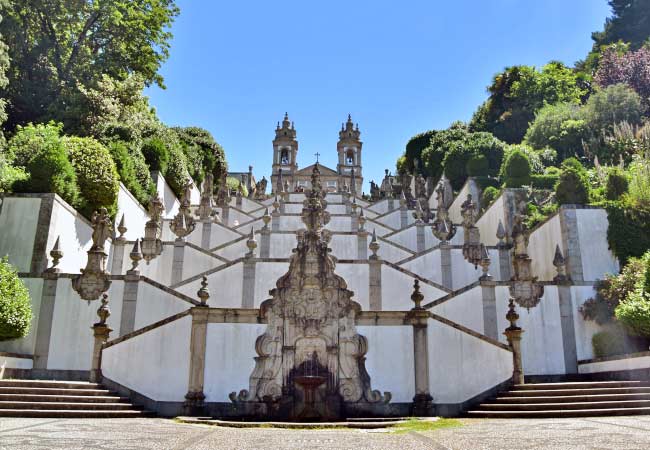
Braga Cathedral
Portugal's oldest cathedral blends Romanesque, Gothic, and Baroque styles. Its magnificent interior showcases gilt wood organs and centuries of religious artistry and architecture.
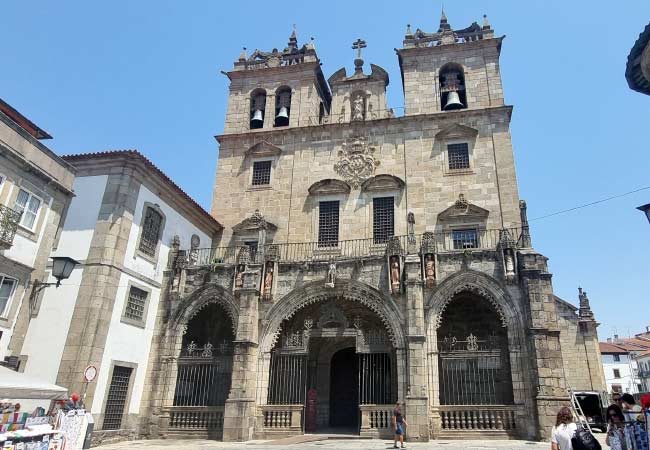
Jardim de Santa Barbara
An enchanting baroque garden beside the Archbishop's Palace, featuring meticulously manicured hedges and vibrant flowerbeds arranged in geometric patterns against medieval walls.
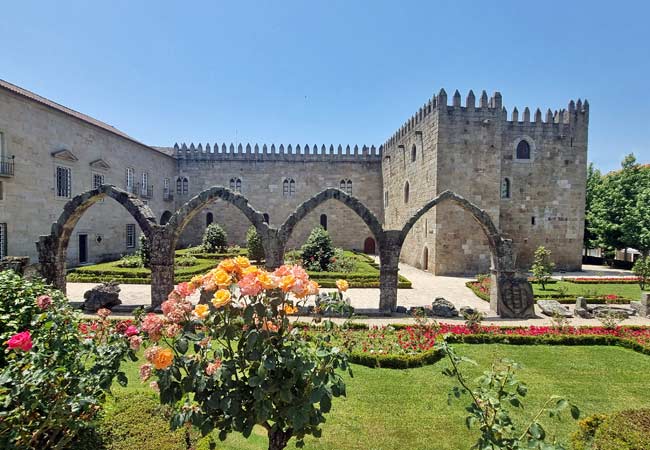
Praça da República
Braga's bustling main square, cantered around a beautiful fountain and bordered by the iconic Arcada building, cafés, and historic architecture.
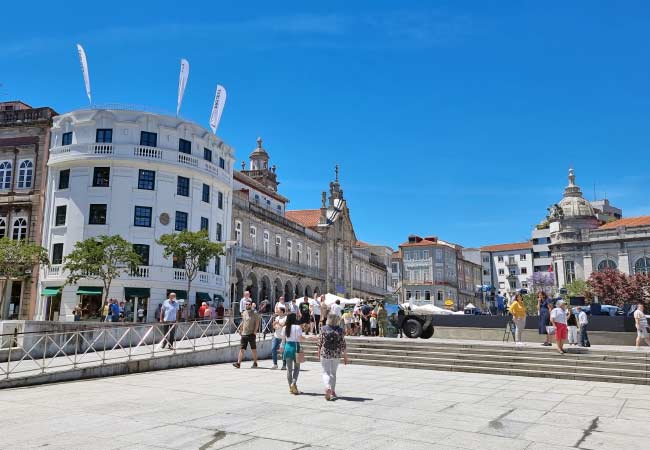
Palacio dos Biscainhos
A grand 17th-century baroque palace-turned-museum displaying noble Portuguese lifestyle through period furniture, gardens, and stunning painted ceilings.
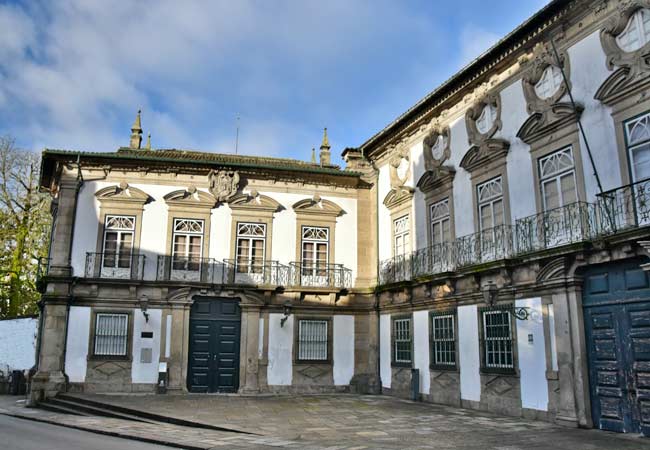
Elevador do Bom Jesus
The world's oldest functioning water-powered funicular, built in 1882, offering a charming ascent to the Bom Jesus sanctuary.
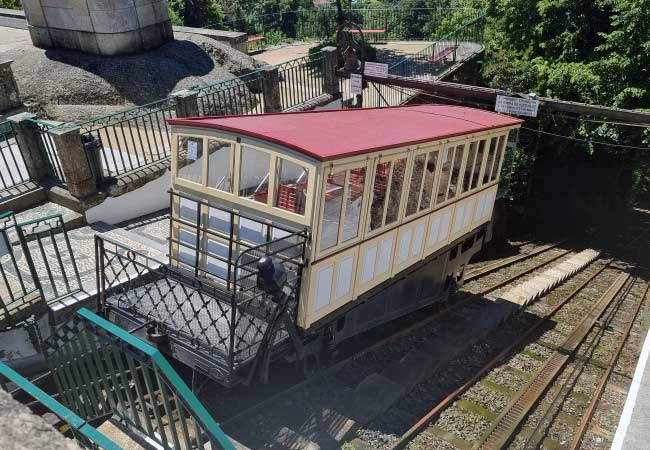
Arco da Porta Nova
An elegant 18th-century baroque arch designed by André Soares, marking the historic entrance to Braga's old town with ornate decorations.
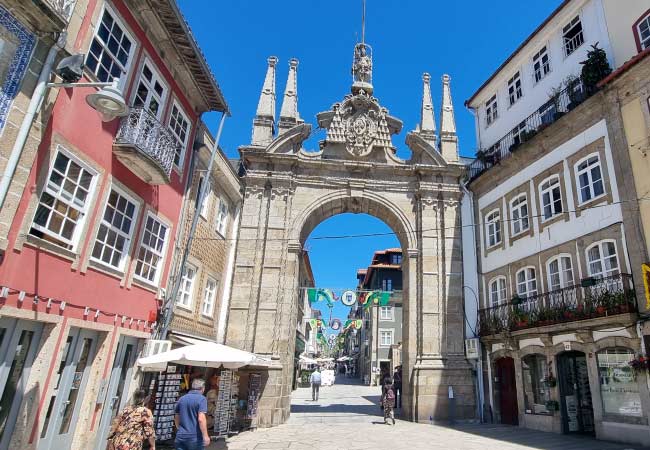
Theatro Circo
A beautifully restored Belle Époque theatre featuring elaborate ceiling paintings and elegant interiors, serving as Braga's premier cultural venue.
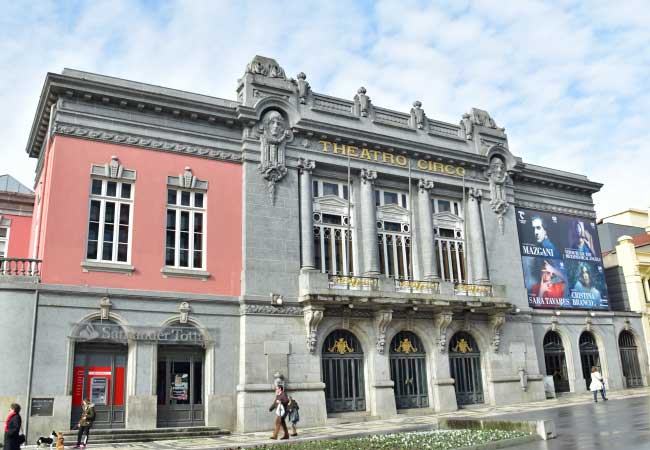
Palácio do Raio
An exquisite 18th-century rococo palace showcasing a stunning blue-tiled façade and elaborate stonework, representing the pinnacle of baroque architecture.
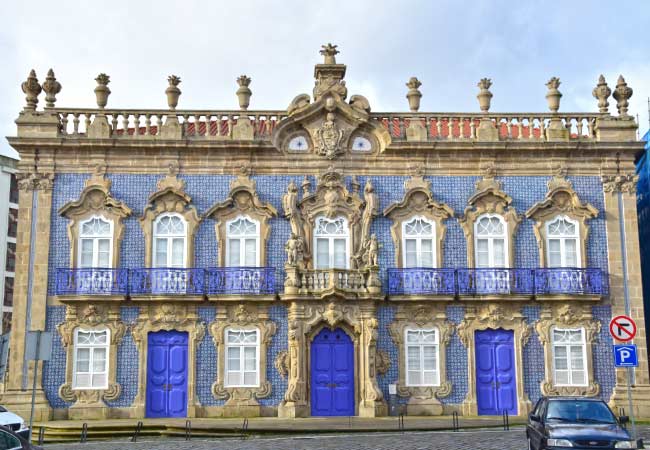
Sights close to Braga
Santuário do Sameiro (7 km from Braga)
A prominent hilltop sanctuary built in the 19th century, offering breathtaking views over Braga. Its impressive dome and grand staircase make it Portugal's second-largest Marian pilgrimage site.
Mosteiro de Tibães (6 km from Braga)
A stunning 17th-century Benedictine monastery featuring baroque architecture, gilded woodwork, and peaceful gardens. Once the headquarters of all Portuguese Benedictine monasteries.
Citânia de Briteiros (15 km from Braga)
An impressive Iron Age hill fort with circular stone dwellings and ancient streets carved into the hillside. One of Portugal's most significant pre-Roman archaeological sites, offering fascinating glimpses of Celtic civilization.
Praia fluvial de Adaufe (5km from Braga)
A serene riverside beach on the Cávado River, featuring green spaces, swimming areas, and shaded picnic spots. A refreshing natural retreat popular with locals during summer months.
The interactive map below highlights all of the major tourist attractions in Braga (Note: Zoom out to see the regional sights that also include the Bom Jesus.)
Legend: 1) Bom Jesus do Monte2) Sé de Braga 3) Jardim de Santa Bárbara 4) Praça da República 5) Palácio dos Biscainhos 6) Elevador Bom Jesus do Monte 7) Arco da Porta Nova8) Theatro Circo 9) Palácio do Raio 10) Igreja de Santa Cruz11) Largo do Paço 12) Convento dos Congregados 13) Capela De São Bentinho 14) Igreja de São Marcos15) Convento do Populo 16) Capela da Torre 17) Termas Romanas
Sight of the Braga region: 18) Santuário do Sameiro 19) Mosteiro de Tibães20) Citânia de Briteiros 21) Praia fluvial de Adaúfe
Have you considered a tour of Braga?
Small group tours are an enjoyable and informative way to discover Braga while providing a chance to meet fellow travellers. We have worked with GetYourGuide.com for the past seven years, and some of the best tours they offer for Braga include:
The main sights of Braga
Bom Jesus do Monte
The baroque stairway of Bom Jesus ascends 116 meters through a series of zigzagging flights, incorporating 17 landings with chapels depicting the Stations of the Cross. Built between 1722 and 1811, each chapel contains life-sized terracotta statues dramatizing Christ's passion.
The staircase's architectural design uses sacred geometry - the steps narrow as they rise, creating a forced perspective that makes the church appear larger from below. At the summit, the neoclassical church (completed in 1834) houses an important 18th-century organ and an altar crafted from Brazilian jasper.
The surrounding park contains historic grottoes, lakes, and viewpoints offering panoramic views of Braga's valley.
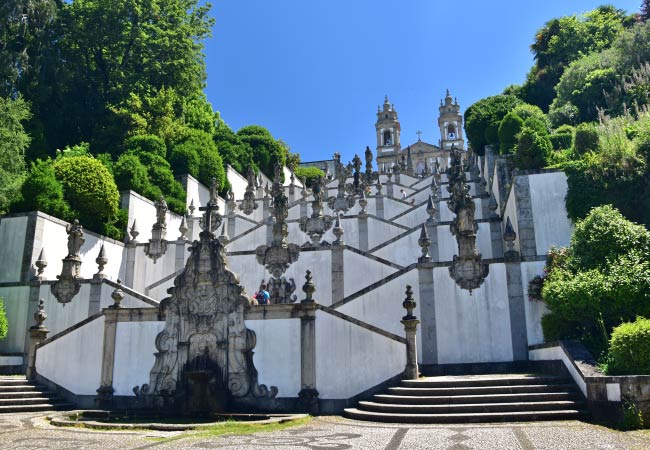
The ornate baroque staircase of Bom Jesus do Monte symbolises humanity's spiritual ascent towards heaven
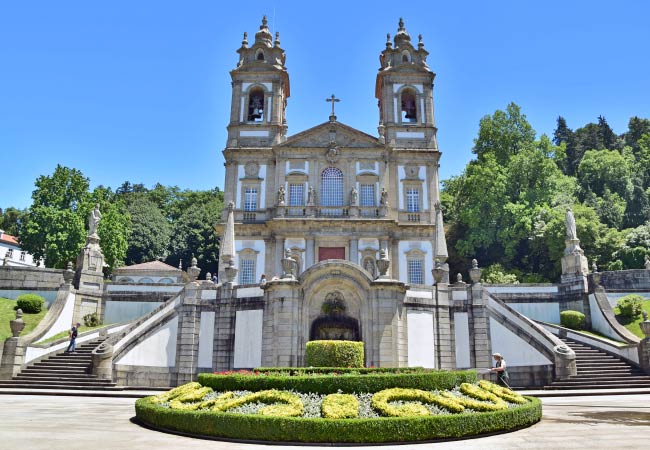
Sé de Braga
Portugal's oldest cathedral, dating to 1089, with continuous religious activity for over 900 years. The building blends Romanesque, Gothic, Baroque, and Manueline styles due to centuries of modifications. Its highlight is the gilded organ from 1737, featuring uniquely horizontal trumpets - a rare characteristic in European church organs.
The cathedral houses the tomb of Henry of Burgundy, father of Portugal's first king, and contains Portugal's oldest church bells. The Kings' Chapel features elaborate baroque tilework depicting the life of the Virgin Mary.
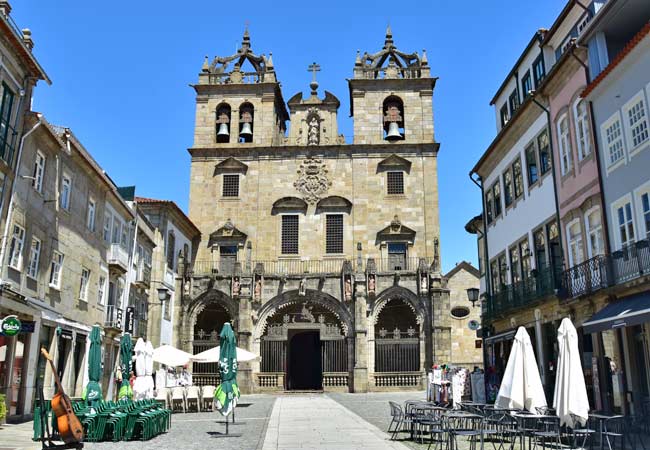
The Gothic Se Cathedral
Praça da República
This central square marks the medieval heart of Braga, where the city's commercial and civic life has cantered since the 14th century. The square's focal point is the Nossa Senhora do Pilar fountain from 1723, which once served as the city's main water source.
The square's north side houses the iconic Arcada, an 18th-century arcade building where locals have traditionally gathered for coffee and conversation. The square features the Baroque Congregados Basilica and the medieval Torre de Menagem, the last remnant of Braga's castle.
Today, the plaza hosts traditional festivals and remains a popular meeting point for locals.
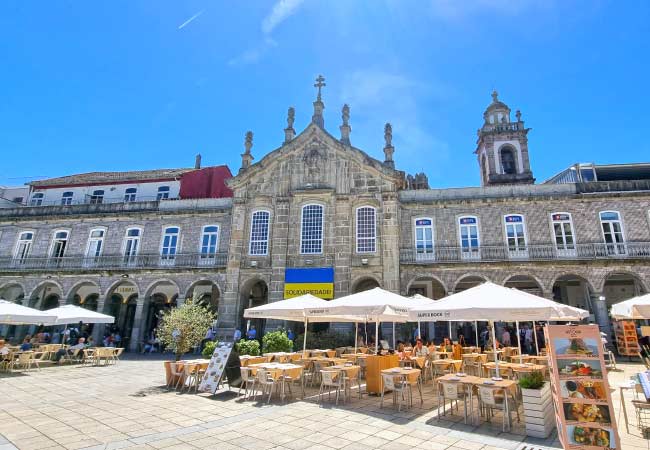
The Arcada
Palácio dos Biscainhos
This 17th-century baroque palace, built by the wealthy Biscaínhos family, contains one of Portugal's finest collections of period furniture and decorative arts. The palace's gardens feature unique baroque elements including hidden fountains, statuary, and a rare surviving example of an 18th-century hedge maze.
Inside, the palace's ceilings display elaborate trompe l'oeil paintings by Manuel Furtado de Mendonça. The kitchen still contains its original 17th-century tiles and cooking equipment, providing insight into aristocratic domestic life. In the former stables, visitors can examine an extensive collection of 18th-century horse-drawn carriages, including ceremonial coaches used by Braga's archbishops.

Bom Jesus Elevator
Built in 1882, this funicular is the world's oldest water-powered elevator still in operation. It uses a counterweight water ballast system: the upper car's tank is filled with water to descend, pulling the lower car up the 274-meter track. The system remains virtually unchanged since its inauguration and operates without any modern power source.
The 3-minute journey offers views over Braga and leads to the Bom Jesus do Monte sanctuary. Regular maintenance keeps this Victorian engineering marvel running efficiently using its original mechanism.

Convento do Populo
The 16th-century Augustinian convent now serves as Braga's city hall. The building's facade combines Renaissance and Mannerist elements with a central clock tower added in 1906. Original cloisters feature granite fountains and geometric tile patterns. The chapter house contains preserved 17th-century frescoes depicting scenes from Saint Augustine's life. The former convent kitchen retains its massive original fireplace and copper cooking vessels.
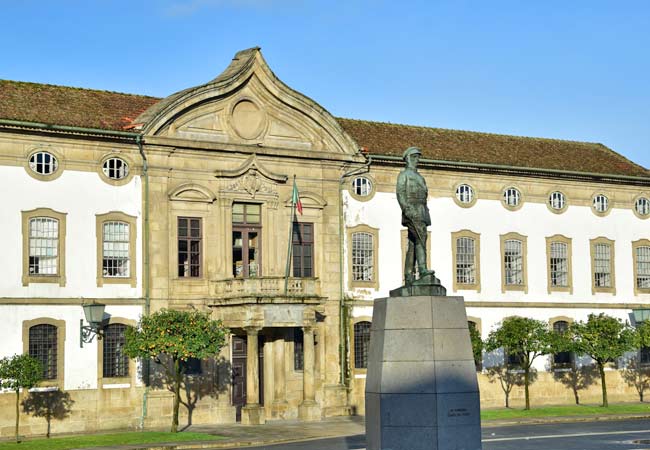
Capela da Torre
The medieval chapel dates to the 14th century, built as a private oratory for a noble family's tower house. Gothic elements include pointed arch windows and original stone corbels carved with grotesque faces. The chapel houses a rare 15th-century wooden Virgin and Child statue, painted in original polychrome. Medieval wall paintings discovered during restoration show scenes from the life of Saint Catherine. The bell tower contains one of Braga's oldest surviving bells, cast in 1399.
Palácio do Raio
This 1752 baroque townhouse represents architect André Soares' masterwork, with a facade covered in elaborate rococo stonework and blue azulejo tiles. The building's asymmetrical design breaks from traditional baroque rules, creating a uniquely dynamic appearance. Inside, the original 18th-century painted ceilings remain intact, along with period furniture and decorative arts. The palace later served as a bank and medical facility before its restoration.

Arco da Porta Nova
This 18th-century baroque arch marks the western entrance to Braga's medieval core, built in 1512 and redesigned in 1772 by André Soares. The arch's facade features intricate baroque stonework including the royal Portuguese coat of arms and the figure of the Virgin Mary, Braga's patroness. The structure served as both a defensive gate and a symbolic entrance for visiting dignitaries. Its interior passage contains the original guard rooms where city officials once collected taxes on incoming goods.

Theatro Circo
Built in 1915, this theatre combines French baroque and art nouveau styles, with one of Portugal's largest stage areas. The main auditorium seats 899 people beneath an ornate dome painted with allegorical scenes. The original mechanical stage systems from 1915 remain functional, allowing for complex scene changes. The theatre’s facade features distinctive ceramic tile panels depicting theatrical scenes.

Igreja de Santa Cruz
Built in 1625, this church contains one of Portugal's finest collections of 17th-century gilded woodwork. The barrel-vaulted ceiling displays rare painted panels depicting the Legend of the True Cross. Its facade combines unusual elements of both Mannerist and early baroque styles. The church's side chapel holds a notable collection of relics, including pieces believed to be from Christ's cross. The sacristy contains original 17th-century vestment chests with intricate inlay work.
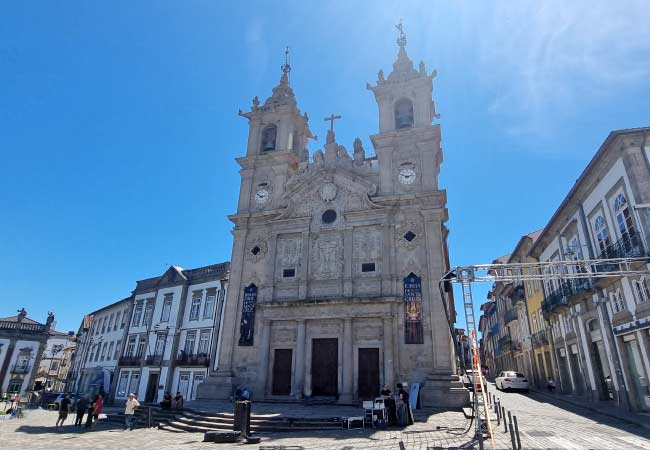
Termas Romanas
The Roman baths lie beneath Braga's historic center, dating to the 1st century AD during the city's era as Bracara Augusta. The 800-square-meter complex contains intact heating systems, hot and cold pools, and changing rooms. Original lead pipes visible in the ruins demonstrate advanced Roman hydraulic engineering. The site's preservation allows visitors to trace the path through different bathing chambers, from the frigidarium (cold bath) to the caldarium (hot bath).
Igreja de São Marcos
The Igreja de São Marcos, an 18th-century Baroque church in Braga, Portugal, stands on the site of a hospital founded in 1508 by Archbishop Diogo de Sousa. Its grand façade features life-sized statues of the apostles, highlighting its architectural significance.
Inside, the church boasts a single nave with vaulted ceilings and frescoes that create a bright and welcoming atmosphere. The main chapel holds the relics of Saint Mark, brought to Braga centuries ago by a Knight Templar, and the remains of Archbishop Diogo de Sousa rest in a striking white jasper tomb adorned with intricate mosaic work.
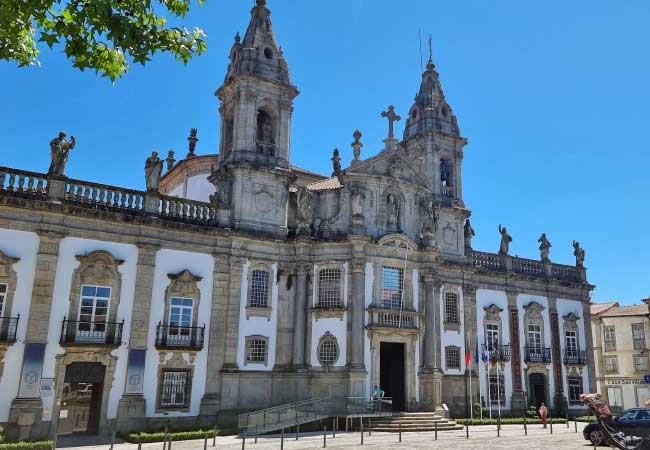
Santuário do Sameiro (7 km from Braga)
The sanctuary stands atop Mount Sameiro at 572 meters above sea level, constructed between 1863 and 1869 as Portugal's second largest Marian shrine. The church's interior features rare Brazilian marble columns and a 200-kilo silver tabernacle. A 46-meter-high dome displays paintings of Mary's life. Four towers house Belgian-cast bells, each weighing over 1,000 kilos. The surrounding terraces offer panoramic views extending to the Atlantic Ocean on clear days.
Mosteiro de Tibães (6 km from Braga)
The 11th-century Benedictine monastery functioned as the order's mother house for Portugal and Brazil from 1567 to 1834. The monastery church contains intricate baroque and rococo gilded woodwork, including a 1660s organ. The former library held over 4,000 rare volumes before the 1834 dissolution of monasteries. The gardens feature a unique water engineering system with 50 gravity-fed fountains from a mountain spring. The kitchen retains 18th-century tile panels depicting food preparation scenes.
Citânia de Briteiros (15 km from Braga)
The Iron Age hill fort thrived from the 2nd century BC to the 2nd century AD, offering vital evidence of pre-Roman Celtic civilization in northern Portugal. Over 150 circular stone houses form neighbourhoods connected by grid-patterned paved streets. A sophisticated drainage system includes stone-lined channels still functioning during rainfall. Evidence of metalworking, weaving, and pottery production indicates a complex urban society. The defensive walls reach 3 meters thick, featuring distinctive fish-scale stone patterns unique to regional Celtic construction. Many houses preserve their original curved stone door frames and central hearths.

Capela De São Bentinho
The chapel sits at a busy intersection in central Braga, built in 1872 with distinctive blue and white tiles covering its exterior. A wrought iron gate protects an unusual ground-level altar where passersby stop to pray throughout the day. The interior walls display 19th-century azulejos depicting scenes from Saint Benedict's life. Local tradition holds that students pray here before exams, leaving pens as offerings for good luck.
Jardim de Santa Bárbara
The Jardim de Santa Bárbara is delightful formal garden sits against the medieval wing of the Archbishop's Palace. Created in the 1950s, its defining feature is the intricate boxwood parterre gardens forming geometric patterns viewable from above. The 14th-century palace wall creates a dramatic backdrop, featuring a preserved medieval arch.






























